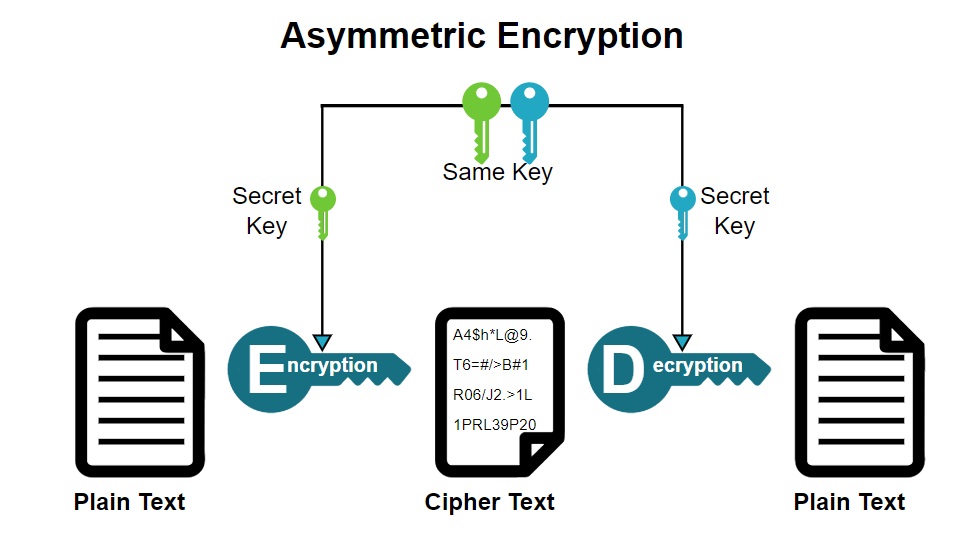Concept of Cryptography in Blockchain
Introduction
Cryptography is a way of securing data against unauthorized access. In the blockchain, cryptography is used to secure transactions between two nodes in the blockchain network. As mentioned above, there are two main concepts in blockchain – cryptography and hashing. Cryptography encrypts messages in the P2P network while hashing helps secure block information and link blocks in the blockchain.
Cryptography primarily focuses on ensuring the safety of participants, transactions, and security against double-spending. It helps in securing various transactions in the blockchain network. It ensures that transactions can only be obtained, read, and processed by the individuals for whom the transaction data is intended.

Learning Objectives:
- Understand the definition and role of cryptography in the blockchain.
- Learn about the two types of cryptography.
- Know all about the cryptographic hash function in blockchains.
This article was published as a part of the Data Science Blogathon.
Table of Contents
The Role of Cryptography in Blockchain
Blockchain is developed with several different cryptography concepts. The development of cryptography technology supports the limitations of further blockchain development. In the blockchain, the main use of cryptography is to protect user privacy and transaction information and ensure data consistency. It plays a key role in maintaining the security of the public network, so it is suitable for maintaining the integrity and security of the blockchain.
What Is Cryptography in Blockchain?
Cryptography is a technique or protocol that secures information from any third party during communication. The word is composed of two Greek terms, the term Kryptos meaning “hidden,” and Graphein, meaning “to write”.
Some Terminology Related to Cryptography:
- Encryption: Converting plaintext to a random sequence of bits.
- Key: A certain amount of information needed to obtain the information of the cryptographic algorithm.
- Decryption: The inverse process of encryption, converting a random sequence of bits into plain text.
- Cipher: A mathematical function, i.e., a cryptographic algorithm, that converts plaintext into ciphertext (a random sequence of bits).
Features of Cryptography
- The intended recipient and no one else can only access the information on a blockchain.
- Information cannot be changed while being stored or sent between a sender and the intended recipient without the addition of new information being noticed.
- The information creator/sender cannot later retract his desire to send information.
- The sender’s and receiver’s identities are verified. Additionally, the information’s origin and destination are verified.
Applications of Cryptography
Here are some of the many applications of cryptography in blockchain:
- Password Encryption: Cryptography is most commonly used in computer security, especially for creating and storing passwords. A user’s password is hashed and compared to the previously saved hash when they logged in. With this method, the passwords are encrypted, preventing unauthorized users from reading them even if they gain access to the password database.
- Cryptocurrencies: Digital currencies like Bitcoin use encryption to secure transactions and thwart fraud. Intricate algorithms and cryptographic keys protect these transactions, making it nearly impossible to tamper with or counterfeit transactions.
- Internet Security: Web browsing security is given using cryptography. It protects users from listening in on conversations and man-in-the-middle attacks. The Secure Sockets Layer (SSL) and Transport Layer Security (TLS) protocols use public key cryptography to encrypt data exchanged between the web server and the client, creating a secure communication channel.
- Online Authentication: Another major use of cryptography is for authentication. This could be for logging into a computer, accessing a bank account, or using a secure network. Authentication protocols use cryptographic techniques to verify the user’s identity and that they have the necessary access privileges to the resource. The storage and verification of electronic signatures also work based on cryptography.
- End-to-End Encrypted Conversations: Cryptography also helps in securing two-way communications such as video chats, instant messages, and email. Even with simple encryption, the message is guaranteed only to be viewed by the intended recipients. But, End-to-end encryption offers consumers a high level of protection and privacy and is frequently employed in messaging apps like WhatsApp and Signal.
Types of Cryptography
Basic cryptography technologies can include two types of encryptions:
- Symmetric-key Cryptography
- Asymmetric-key Cryptography
Symmetric Key Encryption
This type of cryptography focuses on a similar key for encryption and decryption. Most importantly, the symmetric key encryption method is also applicable for secure website connections or data encryption. Also referred to as secret key cryptography. The only problem is that the sender and receiver exchange keys securely. The Data Encryption System (DES) is a popular symmetric key cryptographic system. A cryptographic algorithm uses an encryption key to encrypt data, which must be made available. The person entrusted with the secret key can decrypt the data. Examples: AES, DES, etc.
Features of Symmetric-key Cryptography:
- It is also described as secret key cryptography.
- Both parties have the same key to keep the secret.
- It is suitable for bulk encryption.
- It requires less processing power and faster transfer.

Asymmetric Key Encryption
This encryption method uses different keys for encryption and decryption. This encryption method uses public key and private key methods. This public key method helps completely unknown parties share information like email ID. The private key helps to decrypt the messages and also helps in verifying the digital signature. The mathematical relationship between the keys is that the private key cannot be derived from the public key, but the public key can be derived from the private key. Example: ECC, DSS, etc.
Features of Asymmetric-key Cryptography:
- It is described as public key cryptography.
- It is often used for symmetric cryptography secret key sharing.
- It requires a long processing time to execute.
- It plays a significant role in the authenticity of the web server.

Hash Cryptography Function in the Blockchain
One of the major significant uses of cryptography is cryptographic hashing. Hashing enables immutability in the blockchain. Encryption does not include the use of keys in cryptographic hashing. When the transaction is verified, the hashing algorithm adds the hash to the block, and a new unique hash is added to the block from the original transaction. Hashing continues to combine or create new hashes, but the original trace is still accessible. The hash which single combined is described as the root hash. Hash Function helps in linking the block and maintaining the integrity of the data inside the block, and any change in the data of the block leads to breaking the blockchain. Some commonly used hash functions are MD5 and SHA-1.
Properties of a Cryptographic Hash
- For a particular message, the hash function does not change.
- Any minor change in the data will result in a major change in the hash value.
- The input value is not predicted from the output hash function.
- They are fast and efficient because they rely heavily on bitwise operations.
Advantages of the Hash Function in the Blockchain
- Reduce transaction bandwidth.
- Prevent modifications in the data block.
- Make it easy to verify your transaction.
Use of Cryptographic Hash Functions
- Since the blockchain is also public for everyone, it is important to secure the data in the blockchain and protect the user’s data from malicious hands. So this can be easily achieved using cryptography.
- When a transaction is verified using a hashing algorithm, it is added to the blockchain, and once the transaction is confirmed, it is added to the network forming the chain of blocks.
- Cryptography uses mathematical codes, ensuring that the intended users of the data can retrieve it to read and process the transaction.
- Over the years, many new tools have appeared related to the application of cryptography in the blockchain with different functions.
Advantages of Blockchain Cryptography
There are a huge number of advantages of cryptography in blockchain; some of them are listed below:
- Encryption: Cryptography uses asymmetric encryption to ensure that transactions on their network protect information and communications from unauthorized disclosure and access to information.
- Immutability: This cryptography function is important for blockchain and allows blocks to be securely connected to other blocks and to ensure the reliability of data stored in the blockchain. It also guarantees that no attacker can obtain a valid signature for unopposed queries and their related signatures from past queries.
- Security: Cryptography facilitates transaction records by encrypting and accessing data using public and private keys. Data manipulation by cryptographic hashing is impossible, making the blockchain more secure.
- Scalability: Cryptography makes the transaction irreversible and provides assurance that all users can rely on the accuracy of the digital ledger. Allows you to record unlimited transactions on the network securely.
- Non-repudiation: A digital signature provides a non-repudiation service that protects against any rejection of the message forwarded by the sender. This advantage can be associated with collision resistance because each input value has a unique hash function. This ensures there is no collision between the messages sent, and one message can be easily distinguished from another.
- Prevent hackers: Digital signature prevents hackers from changing the data because if the data is changed, the digital signature becomes invalid. It uses cryptography to protect data from hackers and makes cryptography unstoppable on the blockchain.
Limitations of Blockchain Cryptography
Below are some limitations of blockchain cryptography:
- Difficult access to information: Heavily encrypted and digitally signed information can be difficult to access even for a legitimate user at the most critical decision-making time. The network can be attacked and disabled by an intruder.
- High availability: It is one of the fundamental aspects of information security and cannot be ensured by cryptography. Other methods are needed to protect against threats such as denial of service or complete breakdown of information systems.
- No protection against vulnerabilities: Cryptography does not protect against vulnerabilities and threats that result from poorly designed protocols, procedures, and systems. These problems need to be solved by proper design of defense infrastructure.
- Expensive: Cryptography requires a huge investment of time and money. Public key encryption requires setting up and maintaining a public key infrastructure, which requires a huge investment. Adding cryptographic techniques to sending messages and processing information increases latency.
- Vulnerability: The safety of cryptographic techniques relies on complication and difficulty of mathematical difficulty. Any improvement in resolving such mathematical problems can depart from vulnerable cryptographic techniques.
Conclusion
Cryptography is an essential part of the internal workings of blockchain technology. Public key encryption serves as the basis for blockchain wallets and transactions, cryptographic hashing functions provide an immutability feature, and Merkle trees organize transactions while allowing blockchains to be more efficient. The basic principles of cryptography perfectly correspond to the basic characteristics of blockchain technology. While digital signatures are trusted tools for encrypting blockchain network communication, cryptographic hash has better potential for cryptography.
Key Takeaways:
- The most common use of cryptography is in the application and consensus layers of the blockchain.
- The hashing algorithm mainly helps to create block identity, ensure the integrity of the blockchain, and act as a key component of consensus algorithms such as Bitcoin’s Proof of Work.
- A digital signature discusses with the application layer to verify events by implanting them in transactions.
Frequently Asked Questions
A. The word ‘cryptography’ is composed of two Greek terms – Kryptos meaning “hidden” and Graphein, meaning “to write”. In the blockchain, Cryptography is a technique or protocol that secures information from any third party during communication.
A. The two main types of cryptography are Symmetric-key Cryptography and Asymmetric-key Cryptography.
A. Cryptography in blockchain consists of three main componenets: the encryption, the consensus algorithms, and the peer-to-peer network hash codes.
The media shown in this article is not owned by Analytics Vidhya and is used at the Author’s discretion.








